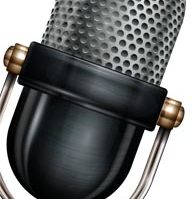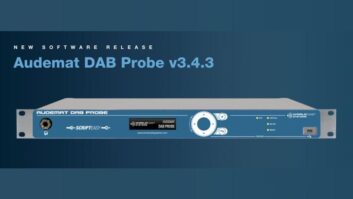This is part of a series to help radio managers understand how automakers are grappling with issues surrounding the “connected car.” For more, seeradioworld.com/dashboard.

Consumers can access various types of radio on the driver’s display on the Audi Q7. Audi recently upgraded its infotainment platform to include more Internet radio options as well as other changes.
Development of a vehicle platform takes longer than typical lifecycles of consumer electronics, so Audi has handled this by consolidating certain functions into a small circuit board called the multimedia extension module. The board can be upgraded model year by model year.
Last year Audi introduced it in the U.S. in the A3 sedan; this year, Audi is introducing the modular architecture on its MIB-2 platform, which has higher graphics capability.
Anupam “Pom” Malhotra spoke with Radio World News Editor/Washington Bureau Chief Leslie Stimson about this and other topics. An engineer and native of New Delhi, India, he is senior manager of connected vehicles for Audi of America, responsible for Audi connected car businesses in the U.S., as well as infotainment and electronics product management.
Malhotra joined Audi in 2010; he had been head of enterprise quality for location-based services for the General Motors connectivity brand OnStar. He was named to his current position in 2012.
RW: Overall, how does Audi view radio in the dash? Broadcast radio, Internet radio, satellite radio. Where do you see its place?
Malhotra: I think that radio is fundamental to the entertainment options that customers expect to see in a vehicle. There’s certainly been a true evolution of radio over the years. And we’ve kept up with every trend that’s come up. From AM to FM to HD Radio to Sirius satellite radio and then, now, of course Internet radio. And within that Internet radio moniker there’s actually several flavors. We introduced Web radio in the A3, which is broadcast Internet radio stations, and we have a refresh with the new RS7. This comes with our MIB-2 infotainment platform, which is an upgrade from the A3 infotainment, and this now will allow Internet radio as well.
We have three different flavors of Internet radio providers that we will be coming in with, one being a subscription service, one a service that allows you to basically select from a list of several million songs and play whatever’s out there. And then another one that actually streams the music to you and allows you to send your preferences — either you like it or you don’t like it — and then based on that [it] adapts the stream to your individual tastes.

Anupam “Pom” Malhotra is senior manager of connected vehicles for Audi of America.RW: Are people connecting using a cable or are they expecting a wireless connection now?
Malhotra: I think they’re expecting it to be as easy as possible. The ideal way to do it is to have it be no different than radio that comes right in the head unit, so I can select from whichever band I want to go into. We’re very close to that implementation now. We have Internet radio that comes in through the smartphone.
And we have an Audi Connect app that sits on your smartphone. We have other applications that work with that app. Your Internet radio app would be accessed by the Audi Connect app.
But the nice thing about it, and the reason we’ve done it this way, is the Audi Connect app itself does not have to be handled by the smartphone. You can handle it from the vehicle’s controls.
RW: From the steering wheel …
Malhotra: Yes, the steering wheel, the same interface that you use in the car to select different options. Say when we go to a media area, within media you have sources … where today you can select from CD, DVD, the jukebox, the hard drive in the car, that is, the SD cards. We also have within there an option for your phone, for Bluetooth.
We also have, since we launched Audi Connect, the option to include your phone through Wi-Fi, and we’re expanding that, offering to include not just Web radio, but also the Internet radio providers as well. That list of options will grow.
What’s even more interesting is we’re bringing in Apple CarPlay and Google Android Auto integration. That really makes this interesting because now I don’t have to guess which provider you [the consumer] like to listen to in the car. The providers of these apps will adapt their apps to work with Apple CarPlay and Android Auto, and we’re giving the access in the vehicle … it’s been designed and streamlined …
The smartphone integration can be controlled directly from the interfaces in the car. So you don’t have to go out and touch the screen like you have to do on your phone. You can use the same controls in the vehicle — that you’re used to using — that are important from a driver distraction standpoint, in order to control these apps.
RW: When will your implementation of the Apple CarPlay and Android Auto be available?
Malhotra: The next-generation Q7 is the vehicle that will first get that, and then every vehicle after that gets it, so that’s about a year away, in the U.S.

An Internet radio station is shown on an Audi Q7 central displayRW: Will drivers be able to see the word “radio” or an icon on the first screen?
Malhotra: No, what will happen is, when you go to the main menu, you have a string of different options like media, navigation, telephone. Within that ring of options — we added Audi Connect at one point — where you could go to the online services function.
Now we’ve also added a smartphone interface, and if you have an Android phone plugged into the USB in your vehicle it will show Android Auto. If you have an iOS phone plugged in, it shows Apple CarPlay. When you select that option … what you see on the screen is actually being projected from your phone. So your phone screen is blank and sitting in your console somewhere.
RW: You’re not tempted to look at it …
Malhotra: You’re not going to be able to touch it, and the controls are there with the Apple configuration. … You see the icons that you’re familiar with seeing on an iPhone … the music icons, your iTunes library’s available, you have the navigation icon, telephone icon, the messaging icon. And if you have Android Auto, you also have a similar set of icons, except they’re laid out in Android format.
So you’ll have access to the Google Play store directly through a tablet that we are bringing into the car for rear seat entertainment. This is a tablet that Audi has developed. … It still is a touchscreen as well. But the big thing is, in addition to working over Wi-Fi in the car, it can also directly access Audi Connect in the vehicle. So you can plan a destination in the back, send it to the front, and the driver can accept it.
RW: So the driver doesn’t have to do all the thinking…
Malhotra: If you’re on a vacation and you have kids in the backseat, it gives them something to do. … It will also let you stream the DVD you have in the vehicle directly to the backseat. Today, our DVD players only allow the stream to be visible when the car’s stationary. As soon as the car starts moving, the DVD blanks out, so its usefulness is a little bit limited as a result of that. Now, as a rear-seat entertainment system, we can use that front DVD, instead of putting a separate DVD player in the back, the front DVD can stream directly over Wi-Fi to the tablet … We think entertainment in general can be in the car is evolving in many different ways.
RW: And to be clear, you’re including AM, FM analog, HD Radio, Internet radio stations and satellite radio in that entertainment system…
Malhotra: Yes.
RW: Do you see AM and FM analog always being in the dash? I’m asking because broadcasters see all the choices in the dash and some of them are worried about that.
Malhotra: I think there will be a time where you have to start looking and saying, is it time to maybe de-select a particular option? But we haven’t quite gotten to that point yet. We continually have evaluations — a lot of discussion about AM radio — about does it make sense. But if you look at the U.S., you still have a lot of national parks that [operate] an AM station for information; a lot of sports channels that broadcast on AM stations, a lot of listeners for that; so we have made the decision that we will continue to keep AM as part of our suite. I know that there are some efforts underway, by even the government, to encourage AM operators to upgrade to FM.
RW: Yes, on FM translators.
Malhotra: Because that certainly gives a higher fidelity of sound. We will continue to monitor those developments. At some point, I think, the radio industry’s situation on AM radio will probably drive what we do. … But yes, it’s one of those things where we just have not seen the need to discontinue a particular option.
FM certainly has a huge following. HD Radio in certain markets improves the quality of what you hear from FM. They continue to evolve their offerings as well. SiriusXM satellite radio — that has gone from people questioning why people would pay for radio to now, sometimes you miss the BBC or Bloomberg in the car and the kids want the Disney channel. … So it’s one of those things where I think they’ve made their place in the sand.
For us, it always becomes a question about do we limit the choice of our customer because of some reason. And that’s a dangerous place to go. So we tread carefully there. Audi’s more about letting the choice be there, and if a particular set of customer only uses satellite radio, that’s their choice. And another customer, in the same family perhaps, may like to listen to FM radio.
Internet radio, I think, is an interesting development because now, the industry itself has an avenue of delivering content in a new way. And Internet radio is riding along the wave of connectivity in cars. So as connectivity in cars goes up — we’re at about 60 to 70 percent install rates on connectivity in our vehicles, so about 70 percent of our cars are connected today.
RW: Connected meaning with a tether or wirelessly?
Malhotra: No, all embedded connectivity — built-in connectivity over a cellular connection, with 4G LTE connection. It’s a very high-speed connection and therefore, very high-quality streaming. That gives us the ability to bring Internet radio in a very realistic way, and meaningful way. We’re still exploring the space to see how the space grows. But clearly we’ve got platforms being developed, both on smartphones and within the head unit that will take advantage of all these developments.
RW: Some in the radio industry were shocked when BMW chose to drop AM from the electric i3 and i8.At the time, they said that the motor caused interference to AM reception. And broadcast engineers are asking why they can’t solve it.
Malhotra: It is a problem. We have experienced the same types of development issues, interference issues, especially in electric vehicles. They tend to be more susceptible to that kind of interference, because it’s an analog signal. …
It can be solved. It costs money to solve it. Audi has taken the position that we want to solve that challenge. And so we are not letting go of AM, at this point at least. But we are closely monitoring how the industry develops. I do think that, at some point, just like [the] analog cellular industry transitioned out, because you can use the airwaves for much more efficient, much higher-quality transmissions, that at some point, it may actually make sense for even the government to come in and say “It’s time.” We’ll be monitoring that to see how that goes, but again, we’re not about pushing that to happen, necessarily.
RW: Is it an antenna issue? Because the antenna’s embedded in the glass or the bumper…
Malhotra: It’s about how the antenna’s shielded and the interferences that happen with the battery in the vehicle. Because … you have a lot of electromagnetic waves in the vehicle because it’s an electric vehicle, the potential for interference increases. Especially with an analog signal, because an analog signal is not defined to a particular spectrum; it’s very wide and it tends to be very inefficient in terms of it bleeds a lot.
Even though you might be targeting a particular frequency, you’ll have signals that are in other frequencies around that band as well. And that tends to cause interference issues. So you have to do a little bit more work to protect and shield, which adds cost. It adds development time; it adds cost to the vehicle.
From a customer standpoint, we think at this point, those costs are likely to be manageable. At some point, I think you know, when the industry does evolve into a standard that doesn’t have to necessarily rely on AM, or if the amount of following that’s out there for AM goes down, I think that will change.
But I think it has to be driven more by the government than the industry. If national parks continue to use only AM channels for their broadcasts, then I don’t think we’re ever going to be able to get away from that, right? When are they going to [migrate] to FM? And that could drive the rest of the industry.
Comment on this or any story to radioworld@nbmedia.com.







